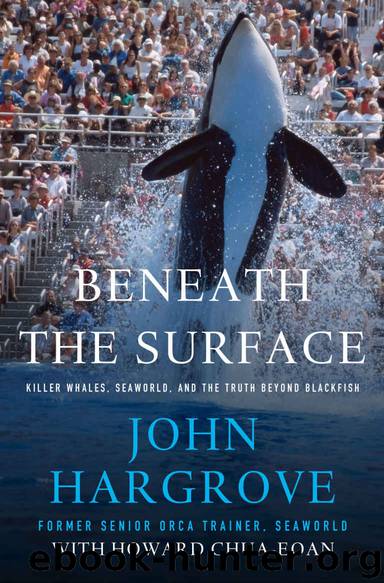Beneath the Surface: Killer Whales, SeaWorld, and the Truth Beyond Blackfish by John Hargrove & Howard Chua-Eoan

Author:John Hargrove & Howard Chua-Eoan [Hargrove, John]
Language: eng
Format: epub
Publisher: St. Martin's Press
Published: 2015-03-23T14:00:00+00:00
8
Getting with the Artificial Program
I was beyond excited to be a member of the special team that was assembled one spring morning in 2000 in San Diego. I was still a relatively junior member of the Shamu Stadium orca-training squad. But I had been assigned to be part of what everyone on staff described as a historic event: the first artificial insemination of a female killer whale in the world. I felt as if I were a scientific pioneer.
The project had been years in the making, starting sometime in the 1990s with the first attempts to collect semen from a male orca. Now, in April 2000, after about six months of training, Kasatka had been sufficiently desensitized to the invasiveness of the procedure, making it possible for us to carry it out the way it had been mapped out step-by-step in advance. Her hormonal readings indicated that she would be ready to ovulate precisely that morning. The sperm had already been flown in from Florida, where it had been harvested and stored.
SeaWorld has had a successful orca-breeding program since 1985. But the corporation decided that artificial insemination would increase the number of orcas in the parks at a faster rate. It was, management explained, a way to sustain the company’s killer whale population. If not, the whales would have died out or suffered from inbreeding, because only orcas in close proximity would be able to mate. Flying the orcas around the country on C-130s or similarly sized aircraft is extremely expensive; and you have to be sure that the orcas you pair up will actually want to mate. A mismatch would be a huge waste of resources. (SeaWorld could no longer diversify its orca population with new whales from the wild because it had stopped capturing orcas due to a public outcry in the 1970s.)
The solution was a program of artificial insemination. It would allow SeaWorld to ship sperm to a park where a female orca was ready to ovulate. Veterinarians and trainers could track her readiness through the levels of hormones in her urine and blood. We could even follow the development of the ovum in her fallopian tubes via ultrasound.
Getting Kasatka ready for the introduction of an alien tube into her body took six months. The procedure required her to roll ventral, that is, to be on her back, with her blowhole, through which she breathed, underwater. She would have to hold her breath for as long as 10 minutes; and she would have to get used to trainers and vets touching her genital area and injecting air into her cervix to open it up for the eventual introduction of the tube. How do you get a whale used to doing all of that without her reacting badly? What do you do when that whale is Kasatka—one of the most dangerous in the SeaWorld system?
She was already trained to roll over ventrally and have her dorsal fin pointing down to the pool floor. That was part
Download
This site does not store any files on its server. We only index and link to content provided by other sites. Please contact the content providers to delete copyright contents if any and email us, we'll remove relevant links or contents immediately.
The Lonely City by Olivia Laing(4750)
Animal Frequency by Melissa Alvarez(4395)
All Creatures Great and Small by James Herriot(4233)
Walking by Henry David Thoreau(3894)
Exit West by Mohsin Hamid(3778)
Origin Story: A Big History of Everything by David Christian(3649)
COSMOS by Carl Sagan(3554)
How to Read Water: Clues and Patterns from Puddles to the Sea (Natural Navigation) by Tristan Gooley(3409)
Hedgerow by John Wright(3276)
The Inner Life of Animals by Peter Wohlleben(3259)
How to Read Nature by Tristan Gooley(3249)
How to Do Nothing by Jenny Odell(3232)
Project Animal Farm: An Accidental Journey into the Secret World of Farming and the Truth About Our Food by Sonia Faruqi(3178)
Origin Story by David Christian(3148)
Water by Ian Miller(3128)
A Forest Journey by John Perlin(3027)
The Plant Messiah by Carlos Magdalena(2883)
A Wilder Time by William E. Glassley(2818)
Forests: A Very Short Introduction by Jaboury Ghazoul(2790)
